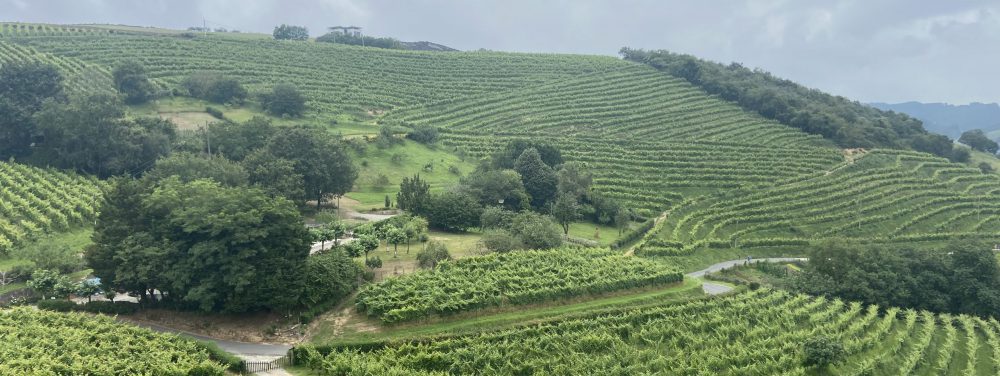Aside from spending three weeks learning Spanish in an immersion program, the beautiful Basque beaches were the main draw for me to visit San Sebastian. The beach has been my happy place since I was a small child. While others enjoy swimming, tossing a ball, or tanning in the sand, I prefer pacing up and down the shores, meticulously combing for sea glass. Anywhere I travel with a coast, I collect all I find and sort my collection by country of origin. My collection includes glass from the West and East Coasts of the United States, Canada, Chile, Belgium, England, Scotland, and Spain.
WHAT IS SEA GLASS
Beach glass or sea glass is the worn-looking glass that washes ashore with soft edges, sandy texture, and a foggy opaque appearance caused by the churning in the churning of salty waves and sand. For me, it is physically impossible to leave the glass I see on the beach. Pieces that are “done” or worn enough I pocket, and those that are still jagged or clear I toss back in the ocean with the hopes that they are ready the next time they wash ashore. Each piece of glass is a unique reflection of years spent at sea. A shard or glass takes ten to fifty years to achieve optimal shape, texture, and color. It is impressive how the types of sea glass that wash ashore reflect the culture in which they are found. The United States is a beer-centric social community. As a result, the dominant color of sea glass found along the coasts is beer bottle brown. In Spain, the most prevalent glass type is dark wine bottle green. Though the glass is often unrecognizable as to what it once was, some of the pieces maintain identifying markers of its former life. The ridges of a bottleneck, the indentation of a bottle base, or faded letters that once formed words etched into the glass.
Years of collecting have taught me that the hours on either side of low tide are ideal for scavenging. The tide is slack at this time, and treasures are less likely to be pulled out to sea. This presents its own challenge in revealing so much of the beach that it is hard to canvas it all before the incoming waves cover it again. My combing method involves tight zig-zags along the water, working upwards with the tide to thoroughly survey the most beach before it is washed away.
Thursday, August 15th, was a national holiday in Spain, so different members of our group celebrated the long weekend in our own ways. Some traveled to other regions of Spain or completed an eight mile hike. I chose to dedicate each day of the weekend to a different beach in San Sebastion and determine the best beach glass collecting.
ONDARRETA
I started on Thursday at Ondarreta Beach, the one nearest to the hotel where we are residing. This beach is the smallest of the ones in San Sebastion but is the only one with small patches of rocks sprinkled throughout the sand, where it is best to find sea glass. The low tide was around 3:30 pm, so I arrived at the beach at about 2. On this beach, I saw hundreds of pieces of sea glass ranging in size from an entire wine bottle base to a grain of rice. The majority of the pieces I found were shades of green. The darker green shards looked like the slate stones on the beach and were hard to identify if not for the unique way glass retains moisture when lying on the sand. Sometimes I wasn’t even convinced what I had picked up was glass until I held it against the sun and the faintest sliver of green glow shown through. Other greens were vibrant like a 7Up bottle or faint like a sea mist. Some glass was a blue-green hybrid, reflective of the sea color from which they had come. To my surprise, the most uncommon glass color I encountered was brown. The browns I did find were not the uniform beer bottle brown like in the United States but ranged from opaque dark brown to orangy-yellow.
ZURRIOLA
On Saturday, I traveled across the Urumea Itsasadarra River to Zurriola Beach. This beach is popular among surfers for the large waves and rough surf. This rough surf is able to churn out the desired glass in a fraction of the time a calmer shore would. While I have heard that Zurriola is the best beach to scavenge beach glass in San Sebastion, my experience here was less than thrilling. After three hours of effort in combing the sand, I came away with only a dozen pieces of glass worthy of collection. This beach has far more unfinished pieces than any of the other two beaches I visited.
LA CONCHA
The final beach of San Sebastian was La Concha (aka Kontxa) Beach, where I spent Sunday. This beach is vast, especially at low tide, when it is possible to walk from Ondarreta around the rock outcroppings all the way to the aquarium. During low tide, a sandbar runs parallel to the beach. One might think that the sandbar would catch the glass pieces as they washed ashore; however, I found more fragments among the sand where the waves lap during high tide. More curious was the fact that almost exclusively white and clear beach glass was present at La Concha. In total, the amount of glass I found was more than that at Zurriola but still only a fraction of what I collected at Ondarret.
Sea glass from San Sebastián is more than just a keepsake—it’s a piece of history shaped by nature. Each fragment tells a story, whether it once belonged to a vintage bottle or a piece of glassware from decades past. The beautiful array of colors wonderfully contrasts those found anywhere else.
